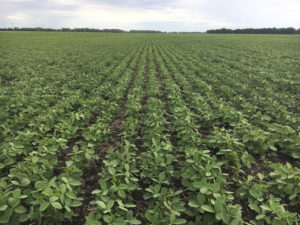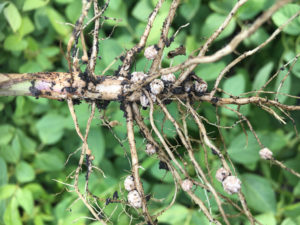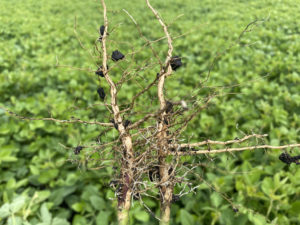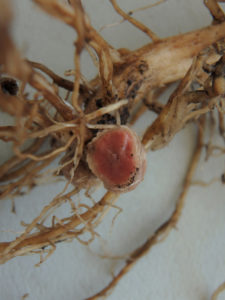Soybean nodulation is the result of a symbiotic relationship between soybean plants and the bacterium, Bradyrhizobium japonicum. Through the process of nitrogen fixation by B. japonicum, nitrogen from the air is made available to the plant. Soil and environmental factors, as well as crop rotation, can influence the survival and activity of B. japonicum and subsequent nodulation.
Nodule Development
The process of nodule development and nitrogen (N) fixation begins with ‘communication’ between soybean roots and Bradyrhizobium japonicum. Bacteria recognize compounds from the root hairs and express ‘nod factors’ (lipochitooligosaccharides) in return. This expression causes root hair modification and allows B. japonicum to enter root hairs where they multiply rapidly. Once formed, nodules can capture atmospheric N and convert it to ammonia (NH3). Soil factors influencing B. japonicum survival include pH, temperature, texture, water content, and soil-available nitrogen.(1)

Figure 1. A healthy soybean field. (Photo courtesy of Manitoba Pulse & Soybean Growers)
Nitrogen Fixation
There is great value to this bacterial relationship as soybeans in the pod fill stage can fix nitrogen at a rate of three pounds of N per acre per day.1 Farmers should examine roots to determine the onset of nodulation and nitrogen fixation. In good conditions, five to seven nodules will develop on taproots by the second week after emergence. Inoculation, adding the bacterium to the seed or soil, is a practice to consider where B. japonicum levels are expected to be low. This is likely to occur in fields that have not recently been planted to soybeans, or in fields where soybean nodulation has been minimal in previous years. Plants with poor nodulation may or may not show above ground symptoms. To identify poor soybean nodulation, dig up plants and inspect the roots (Figures 2 and 3). If little to no nodules have formed, the plant may run low on nitrogen and have limited yield potential. To assess if nodules are actively fixing nitrogen, cut open a nodule and check the coloration. An active nodule has a pink-salmon coloration inside (Figure 4), while inactive nodules will be white inside. If poor nodulation is detected, the inadequate nitrogen level may be corrected in the crop year with an application of nitrogen at the R1 to R3 growth stages.2,3 In a field where poor nodulation occurred, inoculation should be considered for the next soybean crop.

Figure 2. Soybean root with good nodulation. (Photo courtesy of Manitoba Pulse & Soybean Growers)

Figure 3. Soybean roots with poor nodulation. (Photo courtesy of Manitoba Pulse & Soybean Growers)

Figure 4. Cross-section of an active nodule. (Photo courtesy of Manitoba Pulse & Soybean Growers)
Inoculation
A positive yield response from inoculation is expected for first-time soybean fields and those soil environments not supportive of long-term bacteria survival. Soybean producers in the northern and eastern United States have experienced consistent, positive yield responses to re-inoculation.
Even in the Midwest, fields with soybeans for the first-time or fields in a three-year or greater rotation away from soybean are expected to have a positive yield response to inoculation.4 Certain field conditions may hinder B. japonicum survival, and inoculation of soybean fields is recommended when more than one of the following soil conditions are present:
- Soil pH is below 6.0. Low pH can reduce nitrogen fixation.(1,5)
- The field has been flooded for several days. Flooding can create anaerobic conditions detrimental to the rhizobia.(5)
- The soil is compacted. Compaction can reduce nodulation.(6)
- The soil temperature is cool. Nodule formation and nitrogen fixation slow when soil temperatures are below 77 °F.(1)
- Drought has occurred. Dry soil can reduce rhizobia populations and nodulation.(1,7)
- The field is sandy. Sandy soil is more likely to experience drought conditions, which could reduce rhizobia populations.(1) A sandy field may benefit from periodic re-inoculation.
Yield Response
Yield responses to inoculation vary from year to year and field to field. B. japonicum is not native to soils in North America. The success of B. japonicum populations depends on the rate of multiplication and ability to infect root hairs. Some positive yield response scenarios across North America are listed:
- Typical yield increases are 1 to 10 bu/acre.(7)
- Yield improvements of 1 to 2 bu/acre have been reported on fields with a previous inoculum application.(6)
- A yield improvement of 49 bu/acre has been reported on land with no history of soybeans.(7)
Double Inoculation
Commercial inoculation has a target of 100,000 bacteria per seed at the time of seeding. Bacterial numbers are expected to multiply five to eight times under ideal conditions in the first few weeks after seeding.8 Effective N fixation requires millions of bacteria. Double inoculation can be beneficial in fields where soil conditions are not ideal and where soybeans are being planted for the first time. More common in the northern United States and Canada, double inoculation applies inoculant to seed twice and helps plants form nodules at an optimal rate and time. Stacking inoculation products is another practice that can increase nodulation early in the season. With stacked inoculation, a liquid or granular inoculant product is applied to the soil or seed furrow in addition to a seed-applied inoculant.
Summary
The value of nitrogen fixation is the improved soybean productivity resulting from the greater availability of nitrogen provided by the relationship between B. japonicum and soybean root hairs. Take the opportunity to enhance this relationship with inoculation at planting time.
